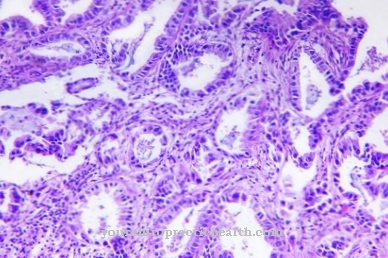The Radioimmunotherapy is a relatively new treatment method for cancer patients. The advantage over conventional treatment methods such as chemotherapy or conventional radiation therapy lies in the high selectivity of the process. The aim of the therapy is to generate a high dose of radioactive radiation in the vicinity of the tumor cells, which kills the tumor cells.
What is radioimmunotherapy?

So-called conjugated radiopharmaceuticals are used. It is a combination of a carrier molecule and a radioisotope. The carrier molecules are usually antigens or peptides.
These dock specifically to the surface structures of the tumor cells, whereupon the radioisotope, usually a short-range beta emitter, destroys the tumor cell.
The antibody must be structured in such a way that it only binds to tumor cells and spares healthy tissue. The two components are coupled via an intermediate molecule.
Function, effect & goals
In the case of chemotherapy, all rapidly dividing cells in the body are attacked. In addition to the tumor cells, this also includes the mucous membrane cells of the mouth, stomach and intestines as well as cells of the hair roots. There are therefore almost always severe side effects such as diarrhea, hair loss, mucosal diseases and changes in the blood count.
Irradiation of the tumor from the outside using X-rays, electron or proton radiation usually also damages parts of the surrounding healthy tissue. In addition, certain organs only endure a certain tolerance dose, which must not be exceeded. In the meantime, several weak rays are often used in radiation therapy, which cross and add up in the tumor to be treated. But the burden on healthy tissue remains significant in many cases.
In the case of radioimmunotherapy, the antibodies injected into the bloodstream specifically target tumor cells throughout the body. In this way, the conjugated radiopharmaceuticals can use imaging and clinical examinations to locate undiscovered cancer sites in the patient's body, since the entire body is searched via the bloodstream. The tumor cells inside the body are irradiated in close proximity and are consequently exposed to a particularly high dose of radiation, while healthy tissue is spared. Since the radioisotopes attach themselves directly to the tumor cells, a lower radiation intensity is required because of the shorter distance to the radiation source.
In addition, tumor cells in the neighboring lymph nodes that cannot be reached via antigens are also reached by the radiation. This is known as the “cross fire effect”. The radioactive substance used is radiated with a half-life of typically hours or days and is largely excreted in the urine via the kidneys.
In some cases, extra medication and fluids are given to protect the kidneys.
In order for radioimmunotherapy to be possible, a surface structure of the tumor cell must first be found that only occurs there. Then an antigen has to be produced which only binds to this type of surface structure. Finding such specific surface structures on the respective tumor cells and the production of suitable antigens are the main difficulties in the development of this therapy.
This has been successful for some types of tumor, such as non-Hodgkin's lymphoma, for example. The surface structure in this case is the CD-20 structure and the beta emitter used is yttrium. In this case, treatment can even be carried out on an outpatient basis.
There are promising approaches to combine radioimmunotherapy with chemotherapy. So far, very few types of cancer are known to have successfully treated radioimmunotherapy. The first, and for a long time the only one, was non-Hodgkin lymphoma. Radioimmunotherapy is a fairly new therapy that has only been used regularly for cancer treatment since the beginning of the 21st century. In many preclinical and, more recently, some clinical studies, it has proven to be more efficient compared to chemotherapy.
It is a very promising concept for the future of tumor treatment and is the subject of intensive research worldwide. The main focus here is on researching new possibilities in the manufacture of carrier molecules.
Risks & side effects
The most common side effect is nausea. Overall, the expected side effects are usually less severe compared to chemotherapy and radiation.
















.jpg)
.jpg)



.jpg)






